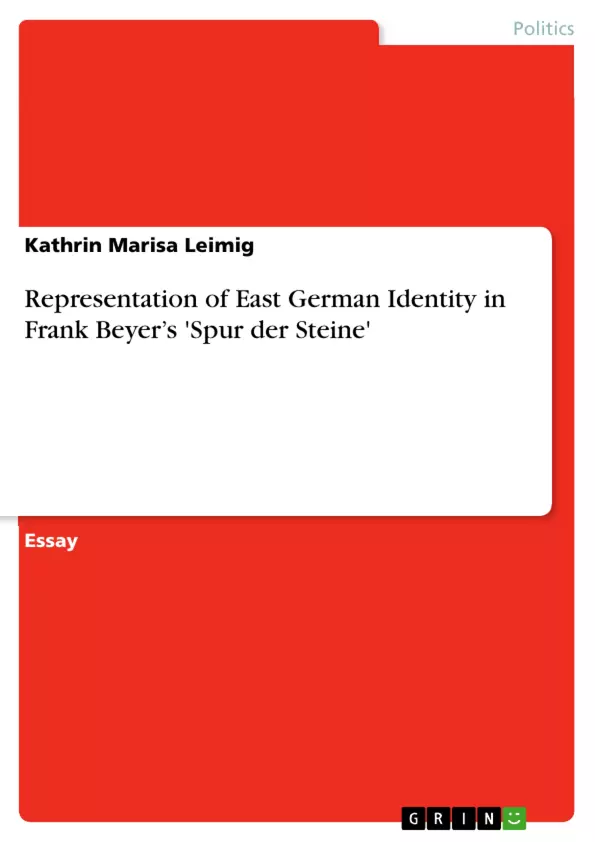Frank Beyer’s Spur der Steine (Trace of Stones) is a controversial 1966 film production released in East Germany that had long been anticipated by Party officials, film artists and the general public. Not only was it the most expensive DEFA- production of the day, but its story had caused debate within the studio in the months leading up to its short-lived release. Beyer’s work presents multiple perspectives on a construction site crisis and thereby openly questions the possibility of “communion between individual destiny and collective destiny predicated by socialism’s utopian goals.”
Table of Contents
- Introduction
- Hannes Balla
- Kati Klee
Objectives and Key Themes
The main objective of this analysis is to explore the representation of East German identity in Frank Beyer's film, Spur der Steine (Trace of Stones), focusing on the interplay between individual aspirations and the constraints of socialist conformity. The analysis examines how the film critiques the socio-political system of the GDR while also attempting to portray a forward-moving society.
- Individual vs. Collective Identity in Socialist Society
- Critique of Party Discipline and State Mechanisms
- Gender Roles and Expectations in East Germany
- The Tension Between Idealism and Reality
- Civil Disobedience and its Consequences
Chapter Summaries
Introduction: This section introduces Frank Beyer's Spur der Steine, highlighting its controversial nature and short-lived release in East Germany. It emphasizes the film's exploration of the relationship between individual and collective destinies within the socialist utopia, referencing Feinstein's analysis of the film as a critical yet affirmative portrayal of the GDR. The initial suppression of the film through state-organized riots is also noted, along with viewer reactions highlighting the film's enduring relevance regarding persistent societal problems.
Hannes Balla: This chapter focuses on Hannes Balla, the charismatic leader of a construction brigade. Balla, despite not being a party member, embodies the ideal proletarian figure – a rebel with a strong work ethic. His acts of civil disobedience, such as a public nude swim, showcase his defiance against authority and the rigid structures of the GDR. Despite facing accusations and labels like "Räuberhauptmann" and "Anarchistenlümmel," Balla's exceptional work performance prevents serious repercussions. His conflict with the Party secretary, Werner Horrath, illustrates the clash between individual ambition and political compliance. Balla’s evolving relationship with Kati Klee, ultimately impacting his political stance, is also discussed. The chapter culminates in Balla's disillusionment and subsequent alcoholic bender following Kati’s pregnancy, triggering a worker's strike, and demonstrating the consequences of his rebellion and the double standards inherent in the system.
Kati Klee: This chapter centers on Kati Klee, a female engineer whose arrival on the male-dominated construction site challenges established gender roles. Her competence and confidence are initially met with resistance from male colleagues and management, highlighting prevailing societal gender expectations. Klee's unwavering belief in the GDR's political system, despite encountering sexism and bureaucratic obstacles, showcases the complexities of idealism within a flawed system. Her relationship with Balla adds a layer of complexity to the themes of individual vs. collective and the tensions between personal desires and political realities within the East German context.
Keywords
East German Identity, Socialist Conformity, Individualism, Civil Disobedience, Party Discipline, Gender Roles, Spur der Steine, Frank Beyer, GDR, Socialist Realism, Political Repression.
FAQ: Analysis of Frank Beyer's "Spur der Steine"
What is the main objective of this analysis?
The analysis explores the representation of East German identity in Frank Beyer's film, Spur der Steine (Trace of Stones), focusing on the interplay between individual aspirations and the constraints of socialist conformity. It examines how the film critiques the socio-political system of the GDR while also attempting to portray a forward-moving society.
What are the key themes explored in the analysis?
Key themes include the conflict between individual and collective identity in socialist society, critique of party discipline and state mechanisms, gender roles and expectations in East Germany, the tension between idealism and reality, and civil disobedience and its consequences.
What is covered in the "Introduction" chapter?
The introduction introduces Frank Beyer's Spur der Steine, its controversial nature, short release, and exploration of the relationship between individual and collective destinies within the socialist utopia. It references Feinstein's analysis and notes the film's initial suppression and enduring relevance.
What is the focus of the "Hannes Balla" chapter?
This chapter focuses on Hannes Balla, a charismatic construction brigade leader who embodies a rebellious proletarian figure. His acts of civil disobedience, conflict with the Party secretary, and evolving relationship with Kati Klee are discussed, culminating in his disillusionment and the consequences of his rebellion.
What is discussed in the "Kati Klee" chapter?
This chapter centers on Kati Klee, a female engineer whose presence challenges established gender roles on the construction site. Her competence, resistance from male colleagues, unwavering belief in the GDR system, and relationship with Balla are analyzed within the context of East German societal expectations and political realities.
What are the key words associated with this analysis?
Key words include East German Identity, Socialist Conformity, Individualism, Civil Disobedience, Party Discipline, Gender Roles, Spur der Steine, Frank Beyer, GDR, Socialist Realism, and Political Repression.
What is the overall structure of this document?
This document provides a comprehensive preview of a language analysis, including a table of contents, objectives and key themes, chapter summaries, and keywords. It offers a structured overview of the themes and arguments presented in the full analysis.
What type of document is this?
This is a preview or summary document intended to provide a structured overview of a larger academic analysis of Frank Beyer's film, Spur der Steine.
For whom is this document intended?
This document is intended for academic use, supporting the analysis of themes in a structured and professional manner.
Where can I find the full analysis?
The provided text is a preview; the location of the full analysis is not specified in this preview.
- Quote paper
- Kathrin Marisa Leimig (Author), 2008, Representation of East German Identity in Frank Beyer’s 'Spur der Steine', Munich, GRIN Verlag, https://www.grin.com/document/167452



